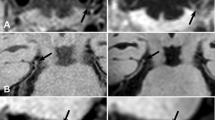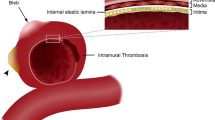Abstract
Objectives
To compare the visibility of intracranial aneurysm wall and thickness quantification between 7 and 3 T vessel wall imaging and evaluate the association between aneurysm size and wall thickness.
Methods
Twenty-nine patients with 29 unruptured intracranial aneurysms were prospectively recruited for 3D T1-weighted vessel wall MRI at both 3 T and 7 T with 0.53 mm (3 T) and 0.4 mm (7 T) isotropic resolution, respectively. Two neuroradiologists independently evaluated wall visibility (0–5 Likert scale), quantified the apparent wall thickness (AWT) using a semi-automated full-width-half-maximum method, calculated wall sharpness, and measured the wall-to-lumen contrast ratio (CRwall/lumen).
Results
Twenty-four patients with 24 aneurysms were included in this study. 7 T achieved significantly better aneurysm wall visibility than 3 T (3.6 ± 1.1 vs 2.7 ± 0.8, p = 0.003). AWT measured on 3 T and 7 T had a good correlation (averaged r = 0.63 ± 0.19). However, AWT on 3 T was 15% thicker than that on 7 T (0.52 ± 0.07 mm vs 0.45 ± 0.05 mm, p < 0.001). Wall sharpness on 7 T was 57% higher than that on 3 T (1.95 ± 0.32 mm−1 vs 1.24 ± 0.15 mm−1, p < 0.001). CRwall/lumen on 3 T and 7 T was comparable (p = 0.424). AWT on 7 T was positively correlated with aneurysm size (saccular: r = 0.58, q = 0.046; fusiform: r = 0.67, q = 0.049).
Conclusions
7 T provides better visualization of intracranial aneurysm wall with higher sharpness than 3 T. 3 T overestimates the wall thickness relative to 7 T. Aneurysm wall thickness is positively correlated with aneurysm size. 7 T MRI is a promising tool to evaluate aneurysm wall in vivo.
Key Points
• 7 T provides better visualization of intracranial aneurysm wall with higher sharpness than 3 T.
• 3 T overestimates the wall thickness comparing with 7 T.
• Aneurysm wall thickness is positively correlated with aneurysm size.



Similar content being viewed by others
Abbreviations
- AWT:
-
Apparent wall thickness
- CRwall/lumen :
-
Wall-to-lumen contrast ratio
- FWHM:
-
Half-width at half maximum
- IA:
-
Intracranial aneurysm
- MIP:
-
Maximum Intensity Projection
- VWI:
-
High-resolution vessel wall imaging
References
Vlak MHM, Algra A, Brandenburg R, Rinkel GJE (2011) Prevalence of unruptured intracranial aneurysms, with emphasis on sex, age, comorbidity, country, and time period: a systematic review and meta-analysis. Lancet Neurol 10:626–636
Molyneux AJ, Kerr RS, Birks J et al (2009) Risk of recurrent subarachnoid haemorrhage, death, or dependence and standardised mortality ratios after clipping or coiling of an intracranial aneurysm in the International Subarachnoid Aneurysm Trial (ISAT): long-term follow-up. Lancet Neurol 8(5):427–33
Wang Y, Cheng M, Liu S et al (2021) Shape related features of intracranial aneurysm are associated with rupture status in a large Chinese cohort. J Neurointerv Surg. https://doi.org/10.1136/neurintsurg-2021-017452
Kataoka K, Taneda M, Asai T, Kinoshita A, Ito M, Kuroda R (1999) Structural fragility and inflammatory response of ruptured cerebral aneurysms. A comparative study between ruptured and unruptured cerebral aneurysms. Stroke 30:1396–1401
Edjlali M, Guédon A, Ben Hassen W et al (2018) Circumferential thick enhancement at vessel wall MRI has high specificity for intracranial aneurysm instability. Radiology 289:181–187
Fu Q, Wang Y, Zhang Y et al (2021) Qualitative and quantitative wall enhancement on magnetic resonance imaging is associated with symptoms of unruptured intracranial aneurysms. Stroke 52:213–222
Zhu C, Wang X, Eisenmenger L et al (2020) Wall enhancement on black-blood MRI is independently associated with symptomatic status of unruptured intracranial saccular aneurysm. Eur Radiol 30:6413–6420
Zhu C, Wang X, Eisenmenger L et al (2019) Surveillance of unruptured intracranial saccular aneurysms using noncontrast 3D-black-blood MRI: comparison of 3D-TOF and contrast-enhanced MRA with 3D-DSA. AJNR Am J Neuroradiol 40:960–966
Tian B, Toossi S, Eisenmenger L et al (2019) Visualizing wall enhancement over time in unruptured intracranial aneurysms using 3D vessel wall imaging. J Magn Reson Imaging 50:193–200
Wang X, Zhu C, Leng Y, Degnan AJ, Lu J (2019) Intracranial aneurysm wall enhancement associated with aneurysm rupture: a systematic review and meta-analysis. Acad Radiol 26:664–673
Zhu C, Haraldsson H, Tian B et al (2016) High resolution imaging of the intracranial vessel wall at 3 and 7 T using 3D fast spin echo MRI. MAGMA 29:559–570
Rutland JW, Delman BN, Gill CM, Zhu C, Shrivastava RK, Balchandani P (2020) Emerging use of ultra-high-field 7T MRI in the study of intracranial vascularity: state of the field and future directions. AJNR Am J Neuroradiol 41:2–9
Blankena R, Kleinloog R, Verweij BH et al (2016) Thinner regions of intracranial aneurysm wall correlate with regions of higher wall shear stress: a 7T MRI study. AJNR Am J Neuroradiol 37:1310–1317
Liu X, Zhang Z, Zhu C et al (2020) Wall enhancement of intracranial saccular and fusiform aneurysms may differ in intensity and extension: a pilot study using 7-T high-resolution black-blood MRI. Eur Radiol 30:301–307
Roa JA, Zanaty M, Osorno-Cruz C et al (2020) Objective quantification of contrast enhancement of unruptured intracranial aneurysms: a high-resolution vessel wall imaging validation study. J Neurosurg. https://doi.org/10.3171/2019.12.Jns192746:1-8
Kadasi LM, Dent WC, Malek AM (2013) Colocalization of thin-walled dome regions with low hemodynamic wall shear stress in unruptured cerebral aneurysms Clinical article. J Neurosurg 119:172–179
Jiang P, Liu Q, Wu J, Chen X, Wang S (2019) Hemodynamic characteristics associated with thinner regions of intracranial aneurysm wall. J Clin Neurosci 67:185–190
Tian B, Toossi S, Eisenmenger L et al (2018) Visualizing wall enhancement over time in unruptured intracranial aneurysms using 3D vessel wall imaging. J Magn Reson Imaging. https://doi.org/10.1002/jmri.26553
Mikami Y, Kolman L, Joncas SX et al (2014) Accuracy and reproducibility of semi-automated late gadolinium enhancement quantification techniques in patients with hypertrophic cardiomyopathy. J Cardiovasc Magn Reson 16:85
Song Y, Hamtaei E, Sethi SK, Yang G, Xie H, Mark Haacke E (2017) COnstrained Data Extrapolation (CODE): a new approach for high definition vascular imaging from low resolution data. Magn Reson Imaging 44:111–118
Larson AC, Kellman P, Arai A et al (2005) Preliminary investigation of respiratory self-gating for free-breathing segmented cine MRI. Magn Reson Med 53:159–168
Qiao Y, Steinman DA, Qin Q et al (2011) Intracranial arterial wall imaging using three-dimensional high isotropic resolution black blood MRI at 3.0 Tesla. J Magn Reson Imaging 34:22–30
Isaksen JG, Bazilevs Y, Kvamsdal T et al (2008) Determination of wall tension in cerebral artery aneurysms by numerical simulation. Stroke 39:3172–3178
Harteveld AA, van der Kolk AG, van der Worp HB et al (2017) High-resolution intracranial vessel wall MRI in an elderly asymptomatic population: comparison of 3T and 7T. Eur Radiol 27:1585–1595
Kleinloog R, Korkmaz E, Zwanenburg JJ et al (2014) Visualization of the aneurysm wall: a 7.0-Tesla magnetic resonance imaging study. Neurosurgery 75:614–622 (discussion 622)
Park JK, Lee CS, Sim KB, Huh JS, Park JC (2009) Imaging of the walls of saccular cerebral aneurysms with double inversion recovery black-blood sequence. J Magn Reson Imaging 30:1179–1183
Zhu C, Cao L, Wen Z et al (2019) Surveillance of abdominal aortic aneurysm using accelerated 3D non-contrast black-blood cardiovascular magnetic resonance with compressed sensing (CS-DANTE-SPACE). J Cardiovasc Magn Reson 21:66
Zhu C, Graves MJ, Yuan J, Sadat U, Gillard JH, Patterson AJ (2014) Optimization of improved motion-sensitized driven-equilibrium (iMSDE) blood suppression for carotid artery wall imaging. J Cardiovasc Magn Reson 16:61
Meng H, Tutino VM, Xiang J, Siddiqui A (2014) High WSS or low WSS? Complex interactions of hemodynamics with intracranial aneurysm initiation, growth, and rupture: toward a unifying hypothesis. AJNR Am J Neuroradiol 35:1254–1262
Kataoka K, Taneda M, Asai T, Yamada Y (2000) Difference in nature of ruptured and unruptured cerebral aneurysms. Lancet 355:203
Mizoi K, Yoshimoto T, Nagamine Y (1996) Types of unruptured cerebral aneurysms reviewed from operation video-recordings. Acta Neurochir (Wien) 138:965–969
Asari S, Ohmoto T (1994) Growth and rupture of unruptured cerebral aneurysms based on the intraoperative appearance. Acta Med Okayama 48:257–262
Hartman JB, Watase H, Sun J et al (2019) Intracranial aneurysms at higher clinical risk for rupture demonstrate increased wall enhancement and thinning on multicontrast 3D vessel wall MRI. Br J Radiol 92:20180950
Song J, Park JE, Kim HR, Shin YS (2015) Observation of cerebral aneurysm wall thickness using intraoperative microscopy: clinical and morphological analysis of translucent aneurysm. Neurol Sci 36:907–912
Zhu C, Wang X, Degnan AJ et al (2018) Wall enhancement of intracranial unruptured aneurysm is associated with increased rupture risk and traditional risk factors. Eur Radiol 28:5019–5026
Acknowledgements
We thank Dr. Jing An (Siemens Shenzhen Magnetic Resonance Ltd) for her effort on MRI technical support. We sincerely thank all the patients and health care workers who participated in this study.
Funding
This study has received funding by the National Natural Science Foundation of China (82001804, 81901197), the Natural Science Foundation of Beijing Municipality (7191003), the Ministry of Science and Technology of China (2019YFA0707103), and the Chinese Academy of Sciences (XDB32010300). Chengcheng Zhu is supported by the US National Institutes of Health (NIH) grant R00HL136883.
Author information
Authors and Affiliations
Corresponding authors
Ethics declarations
Guarantor
The scientific guarantor of this publication is Youxiang Li.
Conflict of interest
The authors of this manuscript declare no relationships with any companies whose products or services may be related to the subject matter of the article.
Statistics and biometry
One of the authors has significant statistical expertise.
Informed consent
Written informed consent was obtained from all subjects (patients) in this study.
Ethical approval
Institutional Review Board approval was obtained.
Study subjects or cohorts overlap
Some study subjects or cohorts have been previously reported in “Wall enhancement of intracranial saccular and fusiform aneurysms may differ in intensity and extension: a pilot study using 7-T high-resolution black-blood MRI. Eur Radiol 2020;30(1):301–307” and “Quantitative analysis of unruptured intracranial aneurysm wall thickness and enhancement using 7 T high-resolution, black-blood magnetic resonance imaging. J NeuroIntervent Surg 2021;0:1–7.”
Methodology
• Prospective
• Observational
• Performed at one institution
Additional information
Publisher's note
Springer Nature remains neutral with regard to jurisdictional claims in published maps and institutional affiliations.
Supplementary Information
Below is the link to the electronic supplementary material.
Rights and permissions
About this article
Cite this article
Feng, J., Liu, X., Zhang, Z. et al. Comparison of 7 T and 3 T vessel wall MRI for the evaluation of intracranial aneurysm wall. Eur Radiol 32, 2384–2392 (2022). https://doi.org/10.1007/s00330-021-08331-9
Received:
Revised:
Accepted:
Published:
Issue Date:
DOI: https://doi.org/10.1007/s00330-021-08331-9




